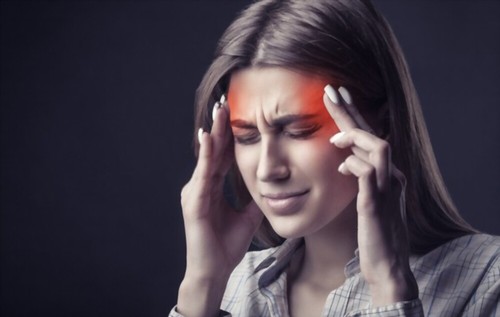Headaches are an unfortunate part of everyday living. Everyone has a headache at some point in their life. 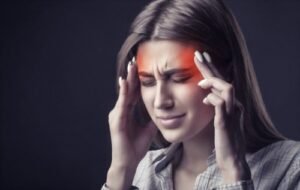 It’s estimated that approximately 50% of the world’s population has suffered from a headache within the last year. For most people they are an occasional annoyance, but others may be plagued by headaches on a regular occurrence, and for some these can be totally debilitating and severely affect their quality of life. There are several types of headache, but the most familiar are:
It’s estimated that approximately 50% of the world’s population has suffered from a headache within the last year. For most people they are an occasional annoyance, but others may be plagued by headaches on a regular occurrence, and for some these can be totally debilitating and severely affect their quality of life. There are several types of headache, but the most familiar are:
Tension headaches – These are the most common type of headache, and although anyone can suffer from these, women tend to be most susceptible, and are twice as likely to have a tension headache than a man. Tension headaches are more common in adults and late teens, although they can occur at any age, and they also tend to be genetic. Also known as stress headaches, they occur when the muscles in the neck, shoulders or jaw become tense and tight, often as a response to stress (mental, emotional or physical), anxiety, depression, eye strain due to poor lighting, poor posture, or injury.
Symptoms are usually characterized by a moderate dull ache or painful pressure on both sides of the head, a tightening band of pain across the temples, or pain in the back of the head and neck. These types of headaches are usually intermittent and occur once or twice during a month, although they can become chronic and occur for 15 days or more a month for several successive months.
Sinus headaches – These occur when mucus builds up in the sinus cavities and the membranes become inflamed and swollen. Often pressure pain is experienced in the forehead, cheeks and eyes. This type of headache is usually triggered by the common cold, flu or allergies. Additional symptoms may include a stuffy nose, fatigue, aches in the upper set of the teeth, and worsening pain on lying down.
Cluster headaches – These are a series of short but painful headaches, occurring 1-3 times a day. Each episode usually lasts from 5 minutes to an hour, although generally they reach full intensity within 5-10 minutes, and consist of an intense sharp or stabbing pain on one side of the head, often concentrated around or behind one eye. They seem to happen at the same time daily and have been called “alarm clock” headaches due to this. Some people are awakened by an attack during the night, and these attacks are more severe.
Typically they produce chronic headaches daily for weeks or months at a time, before disappearing for months or even years. Accompanying symptoms can include red or swollen eyes, a smaller pupil in the affected eye, excessive tearing, and light sensitivity. The exact cause of tension headaches is not known but researchers believed that they have evolved from tension headaches, and are related to a sudden release of serotonin in the body, and an abnormality in the hypothalamus within the brain. This type of headache is much less common and men tend to experience these more than women.
 Migraines – These are the most severe type of headache and affect about one billion people worldwide, and are the third most common illness in the world. They can last for hours or days, and cause a severe throbbing pain and pressure, usually on one side of the face and concentrated behind the eye, which is accompanied by extreme sensitivity to light and sound, nausea and vomiting, a stiff or painful neck, and extreme fatigue following the attack. About 20% of migraine sufferers also experience what is known as an aura, 20-60 minutes before the pain starts, which can include vision changes such as flashing lights, dots, wavy lines, blind spots or blurry vision, but can also represent itself without visual disturbance but include weakness or numbness on one side, a tingling experience in an arm or leg, difficulty speaking or getting the words out, an inability to concentrate, or hearing noises.
Migraines – These are the most severe type of headache and affect about one billion people worldwide, and are the third most common illness in the world. They can last for hours or days, and cause a severe throbbing pain and pressure, usually on one side of the face and concentrated behind the eye, which is accompanied by extreme sensitivity to light and sound, nausea and vomiting, a stiff or painful neck, and extreme fatigue following the attack. About 20% of migraine sufferers also experience what is known as an aura, 20-60 minutes before the pain starts, which can include vision changes such as flashing lights, dots, wavy lines, blind spots or blurry vision, but can also represent itself without visual disturbance but include weakness or numbness on one side, a tingling experience in an arm or leg, difficulty speaking or getting the words out, an inability to concentrate, or hearing noises.
Migraines are usually debilitating and it is estimated that 90% of people are unable to work or function normally during an attack. Whilst the exact cause of a migraine is not known, it is believed that they are the result of abnormal brain activity which temporarily misfires on all cylinders, affecting chemicals and nerve signals, and narrowing blood vessels in the brain, resulting in a change to the blood flow within the brain and triggering severe nerve pain. They are a neurological disorder which is mostly inherited (approximately 80-90% of sufferers have a parent who experienced migraines), although they can also start after a head trauma such as concussion, whiplash, stroke or infection.
It is also possible to experience a “silent” migraine, where there is no throbbing pain but just neurological symptoms such as flashing lights or other visual disturbances, speech difficulty, confusion, and sensitivity to light, sound or touch. Migraines can be triggered by a wide array of stimuli including stress, anxiety, strong odours such as paint or perfume, loud noises, sleep deprivation, hunger, high sugar intake affecting glucose levels, bright or flashing lights or sun-glare, dietary influences such as chocolate, cheese, red wine, artificial sweeteners, food preservatives, changes in the weather and particularly barometric pressure, and hormonal changes.
For women already prone to migraines, the use of oral contraception and hormone replacement therapy can worsen migraines.
Hormonal Headache: As estrogen levels fluctuate during such times as ovulation, menstruation, pregnancy or menopause, it can affect neurotransmitters, including serotonin, which narrow the blood vessels in the brain and trigger a headache. Some women suffer from what is known as a “menstrual migraine”, with similar effects to a regular migraine but usually without an aura.
 Most people rely on medication and over the counter painkillers to treat their headaches, but there is also the complication of side effects, and that they can induce “rebound headaches”, causing the pain to spike after the medication wears off, which often occurs after the body has become accustomed to the medication.
Most people rely on medication and over the counter painkillers to treat their headaches, but there is also the complication of side effects, and that they can induce “rebound headaches”, causing the pain to spike after the medication wears off, which often occurs after the body has become accustomed to the medication.
A natural remedy is to use essential oils, whilst herbal teas can also provide additional support. Aromatherapy has been used for thousands of years and does have some scientific studies to confirm its effectiveness. Natural products are also an excellent preventative tool.
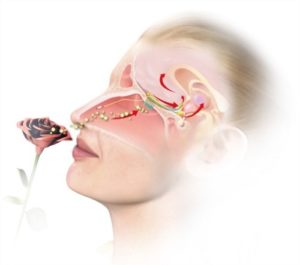 So how do Essential Oils work? They are absorbed by smell receptors linked to the limbic system, controlling stress, breathing, heart rate and blood pressure. They can trigger responses in the body. Studies have proven their effectiveness, for instance in one study they confirmed no significant difference in the use of peppermint oil and an extremely popular over-the-counter pain killer, whilst another confirmed there was less pain after the use of lavender and peppermint than with the pharmaceutical product.
So how do Essential Oils work? They are absorbed by smell receptors linked to the limbic system, controlling stress, breathing, heart rate and blood pressure. They can trigger responses in the body. Studies have proven their effectiveness, for instance in one study they confirmed no significant difference in the use of peppermint oil and an extremely popular over-the-counter pain killer, whilst another confirmed there was less pain after the use of lavender and peppermint than with the pharmaceutical product.
Essential oils can offer relief against many of the root causes including stress, hormonal imbalance, inflammation, muscle tension, and respiratory congestion, in addition to stimulating blood circulation, in particular to the forehead and head, calming the nervous system, reducing nausea and vomiting, and providing analgesic pain relief.
It should be noted that in the case of migraine, it is best to try to use aromatherapy at the earliest indication whilst a stronger smell is still tolerable, or to dilute it more once an attack has started, although lavender seems to be well tolerated even in the throes of an attack. Aromatherapy can also be used as a preventative measure when known stimuli are expected such as changes to the weather, hormonal changes, etc.
So which natural remedy works best for each type of headache? Here’s our recommendation:
Mint
Menthol, the active compound in Mint, is found in many over the counter topical pain relief products, and is a natural analgesic. Applied topically It has an instant cooling effect, inhibits muscle contractions, relieves tension and stimulates blood flow to that area. Menthol also works as a decongestant and anti-inflammatory, reducing swollen membranes, opening the airways, and helping to break down mucus and clear blocked sinuses. Mint is also known to calm the nervous system, relieve anxiety, install calmness and relieve nausea. Works synergistically with lavender.
Suitable for: tension headache, cluster headache, sinus headache, migraine.
Lavender
Linalool and linalyl acetate, the main constituents in Lavender Oil, help to support the limbic system and balance serotonin levels, and this oil is therefore able to induce relaxation and reduce stress, tension, anxiety, and depression. It also has sedative properties to support sleep.
There have been several trials regarding the use of Lavender for the relief of headaches and migraines, and researchers have confirmed that the severity of pain substantially lessened with just 15 minutes of inhalation, and concluded that the “inhalation of lavender essential oil may be an effective and safe treatment modality in acute management of migraine headaches”, as published in European Neurology. It has been shown to reduce both the frequency and severity of migraines.
In another trial, 92 of the 129 headache attacks recorded by participants responded either entirely or partially to lavender. Lavender Oil, with its antispasmodic property, also makes a lovely calming massage oil to reduce tension in the neck and shoulders.
Suitable for: tension headache, cluster headache, migraine.
 Eucalyptus
Eucalyptus
Cineole, an active compound in Eucalyptus Oil is mucolytic and can help to break down the mucus causing blocked sinuses and open the airways. Another compound, eucalyptol, possesses anti-anxiety properties and was shown in studies to actively reduce stress. Eucalyptus Oil also has anti-inflammatory, cooling and analgesic properties and when applied topically can increase blood flow to that area.
Several studies regarding the use of Eucalyptus have confirmed its capabilities for reducing headaches including one published in the Asian Pacific Journal of Tropical Biomedicine in August 2015 which announced its ability to activate and regulate the nervous system in regard to headache, nerve pain and debility, whilst another published in Evidence-Based Complementary and Alternative Medicine, confirmed that inhalation can decrease pain.
A previous study in 2011 confirmed its effectiveness on tension headaches. Eucalyptus Oil helps to lift and revitalise the mind.
Suitable for: tension headache, cluster headache, sinus headache.
Lemongrass oil.
Eugenol, an active compound in Lemongrass Oil, with its anaesthetic, analgesic and anti-inflammatory properties, is believed to have similar abilities to a common over the counter pharmaceutical product according to researchers in Australia, where Lemongrass has a long traditional usage for the relief of headaches. A study in 2009 confirmed its effectiveness for treating headaches.
Furthermore, eugenol also stimulates the release of the neurotransmitter serotonin, helping to relieve stress, tension, depression and mental fatigue, and a 2011 study confirmed its calming ability and noted its positive impact on serotonin and blood-platelet action, both of which are contributory factors to headaches. Lemongrass Oil is also known to relieve nausea.
Suitable for: tension headache, cluster headache, migraine.
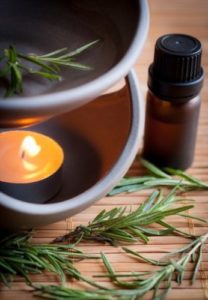 Marjoram Oil
Marjoram Oil
Marjoram Oil has decongestant properties to help clear airways and promote easier breathing. It also possesses antidepressant, anti-anxiety and sedative properties and is a muscle relaxant to soothe neck and shoulder tension. It is also believed to strengthen brain tissue. Applied topically it will boost blood circulation to that area.
Suitable for: tension headache, cluster headache, sinus headache.
Frankincense Oil
Frankincense Oil is packed with 34 different types of monoterpenes, the compounds which demonstrate pharmacological abilities to reduce inflammation, a key contributor to pain. It is also touted to reduce stress and tension, install calmness, and is also known as a purifier to reduce negative energy which can be the core cause of a tension or cluster headache, or a trigger to a migraine. A 2009 study confirmed the use of Frankincense to reduce stress, and also to promote sleep since it has sedative properties.
Suitable for: tension headache, cluster headache.
Chamomile Oil
Chamomile Oil is known for its relaxing and calming abilities and is great for relieving stress, anxiety and insomnia. It is also antispasmodic, which can prevent muscle spasms which may induce a migraine, and has anti-inflammatory and pain relieving properties.
Suitable for: tension headache, cluster headache, migraine.
 Jasmine Oil & Geranium Oil
Jasmine Oil & Geranium Oil
Fluctuating hormone levels are the cause for headaches in many women during ovulation, menstruation, pregnancy or menopause, and can also be a trigger for those suffering from migraine. Both Jasmine Oil and Geranium Oil are known to balance hormones, to bring pain relief and ease depression, and can reduce both the number and intensity of headaches. Geranium is said to be effective when massaged into the abdomen in circular movements.
Suitable for hormonal headaches
How to apply
Firstly it should be noted that Essential oils should never be applied undiluted to the skin, and must be diluted in a suitable carrier oil such as Coconut Oil, Jojoba Oil, etc.
Topically: Apply to the area where the pain is, for instance on and around the temples, forehead, neck and shoulders using circular pressure with your fingertips.
Compress: Apply the mixture of essential oil and carrier oil to a cold or hot cloth and apply to the temples, forehead or neck.
Steam inhalation: For oils to clear the sinuses, add 1 drop to a bowl of steaming water. Steam with a towel over your head for 2 to 5 minutes to clear a stuffy nose and help break up chest and nasal congestion. Take care not to place your face too close to the steaming water as it can scald you.
In the bath: Add a few drops to warm running water to enjoy the aromatherapy effects. Where applicable the oils will also help to clear a stuffy nose and break up nasal and chest congestion.
To aid sleep: Add a few drops to your bed sheets or pillow.
To unblock sinuses: Add a drop to a handkerchief and inhale when your nose starts to feel stuffy.
Aromatically: Add a few drops to your humidifier or diffuser and follow the manufacturer’s instructions.
Note: Ensure that the oils you choose are proper 100% natural essential oils from pure plant extracts and are not fragrance oils which are synthetic and do not offer the same benefits, and should not be used for aromatherapy purposes or applied to the skin.
 Along with Essential oils, nature also offers further relief in the form of herbal teas which can be used as either preventative or remedy:
Along with Essential oils, nature also offers further relief in the form of herbal teas which can be used as either preventative or remedy:
Marjoram tea
A natural vasodilator, marjoram tea can help combat headaches caused by tension or tiredness by relaxing tense muscles and relieving pain, and has a calming effect. It helps to relieve inflammation of the sinuses, and related headaches, and encourages blood circulation. Daily consumption of this tea can help to regulate hormones.
Mint Tea
The antibacterial, antiviral and anti-inflammatory properties help to fight clogged sinuses due to the common cold, viral infections and allergies. Steam from the tea is also a strategic weapon for the sinuses, improving the flow of air within the nasal cavity.
As a natural vasodilator, mint tea can help combat headaches caused by tension or tiredness by relaxing tense muscles and relieving pain. The sedative properties of mint are well known in aromatherapy, promoting wellbeing and relaxation. Mint tea is also an effective remedy for nausea and vomiting.
Fennel Tea
Anethole, Fenchone and estragole, the volatile oils contained in Fennel, benefit upper respiratory infections and help to breakdown phlegm and mucus, thus relieving the severity of a blocked nose and sinuses. Fennel contains phytoestrogens, which act in a similar way to the female hormone estrogen and taken daily can help to support hormonal balance in the female reproductive system.
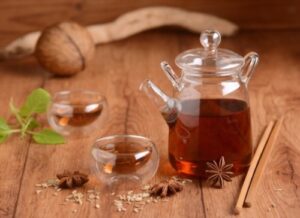 Bedouin Tea (Hebak)
Bedouin Tea (Hebak)
A natural vasodilator, habek tea can help combat headaches caused by tension or tiredness by relaxing tense muscles and relieving pain. Adaptogenic properties found in habek will boost the body’s resilience to stress, regulate cortisol levels and release a small amount of serotonin in the brain to beat depression and promote wellbeing and relaxation, effectively relieving mental stress and anxiety.
The antibacterial, antiviral and anti-inflammatory properties help to fight clogged sinuses and loosen bronchial restriction due to the common cold, viral infections and allergies. Steam from the tea is also a strategic weapon for the sinuses, improving the flow of air within the nasal cavity. Nausea is kept at bay by the antispasmodic properties which prevent the stomach muscles from contracting.
Fenugreek Tea
A naturally occurring compound called diosgenin is found in Fenugreek, which mimics the estrogen hormone that the body produces, helping to balance hormonal imbalance when taken regularly. Alkaloids contained in Fenugreek help to block pain sensory receptors to the brain.
Fenugreek tea was used as a respiratory aid in Ancient times, and science has now upheld this belief after studies have revealed that it is advantageous in the treatment of asthma. It can help to loosen and dissolve the mucus in the respiratory tract and sinuses, whilst its anti-inflammatory properties can reduce inflammation.
Artemisia
Has muscle relaxant and stimulant properties. The main active compound in Artemisia is a thujone, which has many health benefits including blocking a neurotransmitter called gamma aminobutyric acid which has a calming effect on the central nervous system. Artemisia has anti-inflammatory and pain-relieving properties, and clinical trials have confirmed the potential of using Artemisia for these benefits.
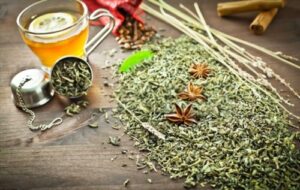 Anise Tea
Anise Tea
Studies have shown that drinking anise tea several times a day is effective to treat the symptoms of mild to moderate depression, with its calming effect being as beneficial as some antidepressants. The tea also reduces the feelings of nausea. It is believed that Anise mimics the effects of estrogen,and so can help to regulate hormones.
Marmaraya Tea
Has antibacterial, antiseptic, antispasmodic and anti-inflammatory benefits to relieve congestion and coughing, whilst also aiding with associated headaches and promoting easier breathing, and has a long history regarding its use in this field. Marmaraya contains naturally occurring compounds known as phytoestrogens which function similarly to mammalian oestrogens and increase estrogen levels in the body, thus regulating hormone levels when taken daily.
Lemongrass tea
Antiviral and antibacterial, this tea is a perfect beverage for those suffering from chest and sinus congestion and inflammation. Lemongrass works as an expectorant, thereby loosening mucus in the throat and respiratory system and allowing it to be dispelled, whilst also reducing pain. Steam from the tea is also a strategic weapon for the sinuses, improving the flow of air within the nasal cavity. Muscle relaxant and anti-inflammatory properties will relax a tense neck or shoulders.
So next time you have a headache, don’t reach for the pills, try a herbal remedy courtesy of Mother Nature.
